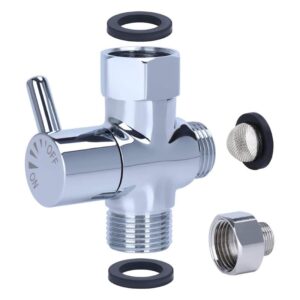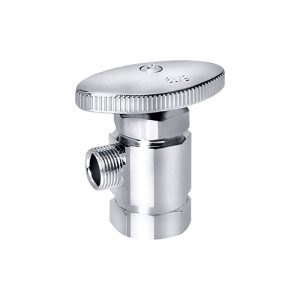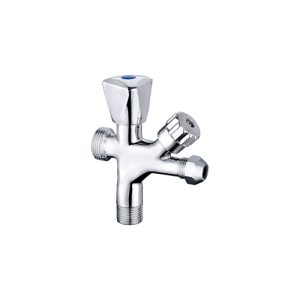Description
Brass 3 Way Angle Valve
JX-0220
- Zinc alloy handle angle valve
- Size: 3/4″ X1/2″,1/2″ X 1/2″
- Name: Brass Angle Valve
- Body Material: Brass
- Brass COMBO Dishwasher Faucet Diverter Valve with Aerator, Sink to Garden Hose Diverter Faucet Adapter, for Bathroom/Kitchen Sink Faucet Connection Portable Washing Machine/Dishwasher (G1/2,3/4″, Chrome)
A 3-way valve has a steady flow rate that can change the flow direction or mix different flow types. Because it has three holes that can be joined to tubes to let liquid or gas flow, it’s also called a multiport valve. Three-way valves have these holes: two inlets, one exit, one input, and two outlets. This is up to the program that links.
Even though it is a multiport valve, the flow rate in each valve stays the same. Though the liquid or gas will be split into two different holes, the flow rate stays the same wherever the valve is used.
How Does 3-Way Valve Work?
A 3-way valve allows a fluid or gas to flow through it in three different ways. Each way can be managed to either stop or start the flow. Usually, the valve has a body in the middle with three ports: one for entering and two for leaving. The primary flow path links one of the outlet ports to the input port, and the secondary flow path links one of the outlet ports to the primary flow path.
When the valve is closed, there is no flow through it. This means that neither the main flow path nor the secondary flow path can move. When the valve opens, one exit port is linked to the input port through the main flow line. On the other hand, the secondary flow line connects the other exit port to the input port.
The valve’s location can change the fluid or gas flow between the two exit ports or stop the flow completely. A three-way valve can mix two streams of gas or liquids by partly opening both exit holes and letting them mix in the main flow line.
What is the Main Features of 3-Way Valve?

Here are some of the best 3-way valve features.
Structure:
With these valves, the third port doesn’t need its pipes or links. The 3-way valve takes care of all of these extra problems and controls more than one valve simultaneously.
Versatility:
The best thing about 3-way valves is their versatility. They can easily manage flow in three ways and offer many tuning choices. Thus, they can be used in several different situations.
Multiple Control Options:
Three-way valves are designed to maximize a single product’s performance. They offer different ways to control fluids, including processing media coming from the entrance by mixing, redirecting, or stopping it. They also maintain the flow very precisely. When flow accuracy is the primary goal, these are the best tools for the task.
Less Expensive:
If you need more than one valve, you can use a 3-way valve. Instead of buying and installing different switches to control each media type, they do it for us. Also, they eliminate the need for a divider or blender. The best part is that 3-way valve prices are also very low.
Self-Maintenance:
The three-way valve’s construction can be changed and made to last. If the valve seat starts to wear away, it sets off a self-cleaning device. Higher-pressure fluids moving through the fluid wash away all kinds of buildups, improving the covering, which was worse because of the loss.
Low Resistance to Flowing Media:
The structure of these valves can change to fit the flow of media. A disc or plug keeps the pressure of the liquid steady at the entry and exit points, which means that the media has the least resistance and pressure drops.

What Are The Types Of 3-Way Valves?
The T-port and L-port valves are called three-way valves because their bodies are shaped like a T and have three parts. Both change the flow to and from the different parts. Still, the L port valve lets you do one thing, while the T port valve enables you to do something else. These are the main kinds of three-way valves:
T-port valve
This valve has a T-shaped opening that lets flow go in three different ways. You can mix, redirect, or skip fluid flows with this valve. A T-port three-way valve has a flow path or hole shaped like a T. The valve can mix, redirect, or avoid fluid flows because it lets flow through it in three ways.
They are the entrance port, the exit port, and the standard port. The hole with the common port is linked to the T-shaped bore, which controls fluid or gas flow.
There are a few distinct methods in which T-port three-way valves can be constructed to function. A disk or plug located inside the valve rotates or slides in response to the opening or closing of the valve, directing the flow to the appropriate port.
The T-port valve is typically utilized to deliver flow in both directions toward the outlet. The presence of fluid is constantly required in a variety of settings. This is accomplished by passing between the valve body and the side port at a pressure that is almost lower.
L-port three-way valve:
It is also known as the 90-degree ball. In this valve, liquids or gases can move from one inlet to one of two different exits. The name “diverter valve” comes from the way it works in the L-port 3-way ball valve. Unlike the T-port valve, the L-port 3-way ball valve only changes the flow in one direction.
Unlike the T-port valve, it can start the flow again, slow it down, or stop it completely. The valve handle is measured in 90-degree ranges, for example, 90 degrees, 180 degrees, and so on, up to 360 degrees. But the direction is always the same, no matter what angle it is at.
The L-port ball valve is very useful when gas or liquid is brought into another pipe from more than one source.
One type is the double L-port ball valve, a four-way valve that checks flow with four pipes hooked up. Furthermore, there are flanged valves whose ends are flanged so that they can be welded or bolted onto any pipe.
Valve manufacturers indicate that the 3-way valve is one of the most popular types because it can be used in various situations and can handle different types of flow in a pipeline or other system.
How to Choose the Right 3-Way Valve?
There are several things to consider when choosing a suitable 3-way valve for a given job.
Pressure and Temperature Ratings:
Find out what pressure and temperature range your system can handle. Select a three-way valve that can handle the temperature and pressure needed. Check the manufacturer’s instructions for the 3-way valve.
Identify the Application:
Identify the Application: Look at what the valve does in a particular situation. Determine whether you need a valve to change the flow, mix it, or stop it completely. If you know the program, it will be easier to cut down the choices.
Size of the Valve:
Consider the size of the valves in your system. Choose a valve that is the same size as the pipes’ width. It is important to use the correct valve size. This will ensure that the system has no limits or issues.
Valve Actuation:
Choose how the valve will be adjusted. One can be done by hand with a button or handle. The other is mechanical and has an electric or gas lift. In addition, a remote-controlled valve is provided. Pick the control method based on your system’s needs and resources.
Expert Advice:
Talk to experts if you want to know more about how the choosing process works. These could be pros, companies that make valves, or providers. They can give you good advice and help you make a smart choice.
Manufacturer and Quality:
Look for 3-way valves made by reputable companies that you can trust. Consider reading reviews from past customers and ask for suggestions if you can. Suitable valves last longer and don’t need much upkeep.
Summary
One of the most important types of ball valves is the three-way ball valve, which has many uses in different industrial systems. They play important roles at different places in a pipe and tube system for gas or liquid flow.
With a mechanism that works with many different system needs, this valve can do different things in different systems simultaneously, proving that it is both cost-effective and flexible. There are many business processes, but the 3-way ball valve can handle all of them. To find out more, consult a proficient valve manufacturer.







